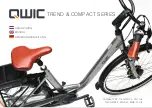
24
25
VII. TECH
Everything changes when you ride on loose surfaces or in wet weather.
It will take longer to stop on loose surfaces or in wet weather. Tire
adhesion is reduced, so the wheels have less cornering and braking
traction and can lock up with less brake force. Moisture or dirt on the
brake pads reduces their ability to grip. The way to maintain control on
loose or wet surfaces is to go more slowly.
D. SHIFTING GEARS
Your multi-speed MOZIE bicycle has an internal gear hub drivetrain and
has been equipped with a Shimano twist shift system.
1. How an internal gear hub drivetrain works
If your bicycle has an internal gear hub drivetrain, the gear changing
mechanism will consist of:
• a 3 or 7 speed internal gear hub
• one shifter
• one control cable
• one front sprocket called a chainring
• a drive chain
a. Shifting internal gear hub gears
Shifting with an internal gear hub drivetrain is simply a matter of moving
the shifter to the indicated position for the desired gear ratio. After you
have moved the shifter to the gear position of your choice, ease the
pressure on the pedals for an instant to allow the hub to complete the
shift.
Remember: shifting with an internal gear system is best done when
coasting, stopped, or back pedaling. Unlike an external derailleur
system, the internal system should not be shifted while pedaling with
too much force. If you must shift while pedaling, reduce your pressure
on the pedals. Excessive tension on the chain makes shifting difficult.
b. Identifying the proper gear
The numerically lowest gear (1) is for the steepest hills. The numerically
largest gear is for the greatest speed. Shifting from an easier, “slower”
gear (like 1) to a harder, “faster” gear (like 2 or 3) is called an upshift.
Shifting from a harder, “faster” gear to an easier, “slower” gear is called
a downshift. It is not necessary to shift gears in sequence. Instead, find
the “starting gear” for the conditions — a gear which is hard enough for
quick acceleration but easy enough to let you start from a stop without
wobbling — and experiment with upshifting and downshifting to get a
feel for the different gears. At first, practice shifting where there are no
obstacles, hazards or other traffic, until you’ve built up your confidence.
Learn to anticipate the need to shift, and shift to a lower gear before
the hill gets too steep. If you have difficulties with shifting, the problem
could be mechanical adjustment. See your qualified local bicycle shop
for help.
c. Adjusting your internal gears
MOZIE has selected internal gears for your bicycle as they provide a
clean look and are relatively easy to maintain. If moving the shift control
one click repeatedly fails to result in a smooth shift to the next gear
chances are that the mechanism is out of adjustment.
With the Shimano 7-gear shifting system, you can easily adjust the
system to facilitate a smooth shift by following these steps:
1. Put the twist shifter in 4th gear.
2. Find the small window on the rear hub that has two small red or
yellow marks on it. If the marks are not aligned across from each
other, turn the adjusting barrel (located at the end of the gear cable
attached to the twist shifter on the handlebar,
Fig 10
) until the marks
line up
(Fig. 12)
.
With the Shimano 3-gear shifting system, you can easily adjust the
system to facilitate a smooth shift by following these steps
(Fig. 11)
VII. TECH
1. Put the twist shifter in 2nd gear.
2. Loosten lock nut.
3. Twist adjustment knob.
4. Line up lines.
5. Tighten lock nut.
If your alignment marks are properly aligned and you continue to
experience shifting that is not smooth then contact a qualified bicycle
shop to have the mechanism examined.
E. PEDALS
1. Toe Overlap is when your toe can touch the front wheel when you turn
the handlebars to steer while a pedal is in the forward most position.
This is common on small-framed bicycles, and is avoided by keeping the
inside pedal up and the outside pedal down when making sharp turns.
On any bicycle, this technique will also prevent the inside pedal from
striking the ground in a turn.
WARNING: Toe Overlap could cause you to lose control and fall. Ask
you’re a qualified bicycle shop to help you determine if the combination of
frame size, crank arm length, pedal design and shoes you will use results in
pedal overlap. Replacement of crank arms or tires can result in a reduction in
toe overlap clearance. Whether you have overlap or not, you must keep the
inside pedal up and the outside pedal down when making sharp turns.
F. TIRES AND TUBES
1. Tires
Bicycle tires are available in many designs and specifications, ranging
from general-purpose designs to tires designed to perform best under
very specific weather or terrain conditions. If, once you’ve gained
Fig. 10
Fig. 11
Fig. 12
Summary of Contents for Carolina
Page 1: ......



































